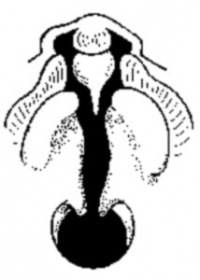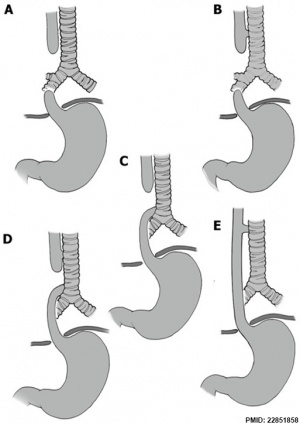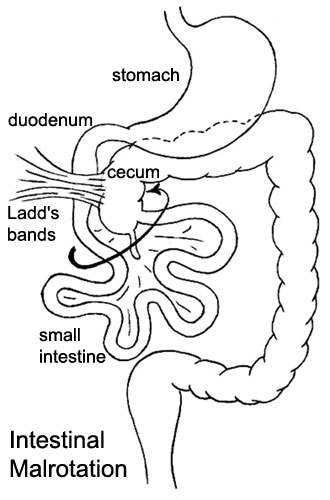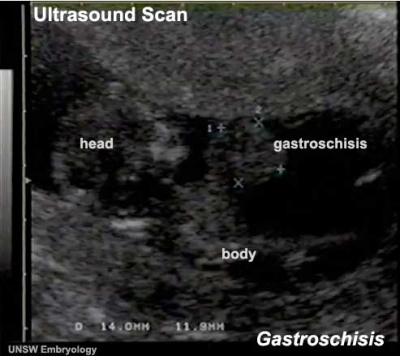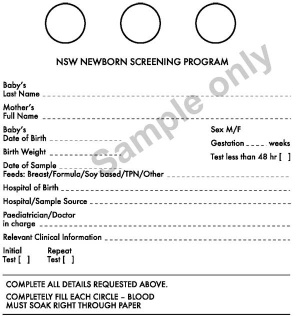BGDB Gastrointestinal - Abnormalities
| Practical 1: Trilaminar Embryo | Early Embryo | Late Embryo | Fetal | Postnatal | Abnormalities | Lecture | Quiz |
Cleft Lip and Cleft Palate
The concepts of cleft palate and cleft lip and palate will be covered in detail in the BGDB Face and Ear Development lecture/practical.
Atresia and Stenosis
The gastrointestinal tract can be considered as a simple tube or pipe, anything which blocks the tube (at different levels) can have different effects.

There are two types of abnormalities that impact upon the continuity of the gastrointestinal tract lumen.
Atresia - interuption of the lumen (esophageal atresia, duodenal atresia, extrahepatic biliary atresia, anorectal atresia)
Stenosis - narrowing of the lumen (duodenal stenosis, pyloric stenosis)
Duplication - incomplete recanalization resulting in parallel lumens, this is really a specialized form of stenosis.
Persistent Vitelline Duct
Abnormal Gut Rotation
Organ Abnormalities
Extrahepatic Biliary Atresia, Accessory Pancreatic Tissue, Anular Pancreas, Accessory Spleen
Motility Disorders
Aganglionic colon (Hirschprung's disease) - abnormalities of neural crest migration.
Herniation Abnormalities
- omphalocele - herniation of the bowel, liver and other organs into the intact umbilical cord, the tissues being covered by membranes unless the latter are ruptured
- gastroschisis - intact umbilical cord and evisceration of the bowel through a defect in the abdominal wall, generally to the right of the cord, with no membrane covering
Omphalocele
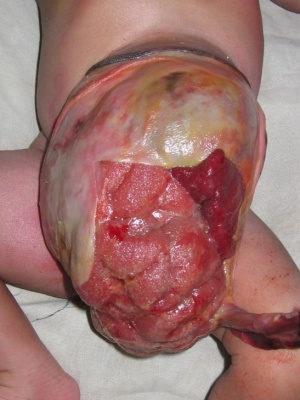
Abdominal wall herniation abnormality occurs in both omphalocele and gastroschisis. Omphalocele involves "covered by membranes" and a lack of normal return of the bowel to the abdominal cavity and has a different position relative to the umbilical cord. The origin differs, as this is a failure of midgut loops to return to the body cavity after initial herniation into the umbilical cord during week 6 - 10.
Gastroschisis
| Gastroschisis is a developmental abnormality occurs due to an abdominal wall defect, that allows the evisceration of the intestine.
|
Clefting
Cleft lip and palate can affect postnatal nutrition, due to the inability of the infant to form a liquid seal on the breast during feeding.
Note - this topic will be covered in detail in the BGDB Practical - Face and Ear Development practical.
Cleft Lip
An abnormality of face development leading to an opening in the upper lip. Due to failure during the embryonic period of maxillary process fusion with the frontonasal prominence. Clefting of the lip and or palate occurs with 300+ different abnormalities. Depending on many factors, this cleft may extend further into the oral cavity leading to a cleft palate. In most cases clefting of the lip and palate can be repaired by surgery.
Cleft Palate
An abnormality of face development leading to an opening in the palate, the roof of the oral cavity between the mouth and the nose. If it occurs alone, due to failure during the early fetal period of palatal shelves. Clefting of the lip and or palate occurs with 300+ different abnormalities. In most cases clefting of the lip and palate can be repaired by surgery.
Polyhydramnios
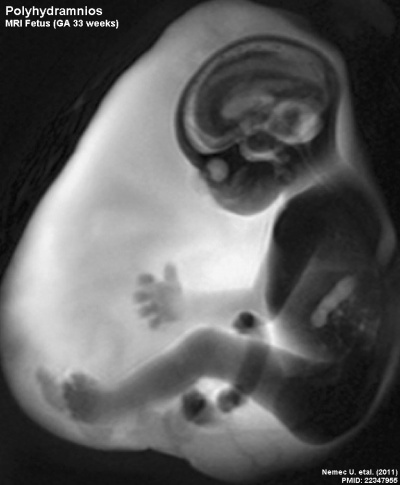
|
Polyhydramnios (hydramnios, amniotic fluid disorder) refers to abnormally high amniotic fluid levels.
| ||||||||
Meconium Peritonitis
A condition caused by intra-uterine intestinal perforation leading to a sterile inflammatory reaction of the peritoneum.
Metabolic Disorders
Inborn Errors of Metabolism (IEMs) are caused by mutations in the specific genes that lead to impaired proteins or enzymes production and are usually detected by the neonatal Guthrie test.
- phenylketonuria (PKU) - 1 in 10,000 live births (about 10 babies per year). PKU causes high blood levels of phenylalanine and severe intellectual disability. A diet low in phenylalanine, started in the first two to three weeks results in normal development.
- galactosaemia - 1 in 40,000 births (about 1-3 cases per year), incidence rate is different for other groups. Babies cannot process galactose, a component of lactose, (enzyme galactose-1-phosphate uridyl transferase) metabolizes galactose in milk sugar. Life-threatening liver failure and infections can occur. A galactose-free diet instituted in the first week is life saving.
- Rarer metabolic disorders - Some fatty acid, organic acid and other amino acid defects can now be detected using Tandem Mass Spectrometry. These much rarer metabolic disorders affect about 15 – 18 babies per year. Early detection is important as diet and medications can treat most of these disorders. Without appropriate management they can cause severe disability or death.
- Links: Guthrie test | neonatal diagnosis | milk | MedlinePlus - Galactosemia
| Gastrointestinal Tract Terms | ||
|---|---|---|
| ||
|
Additional Information
| Additional Information - Content shown under this heading is not part of the material covered in this class. It is provided for those students who would like to know about some concepts or current research in topics related to the current class page. |
Abnormalities and Development
|
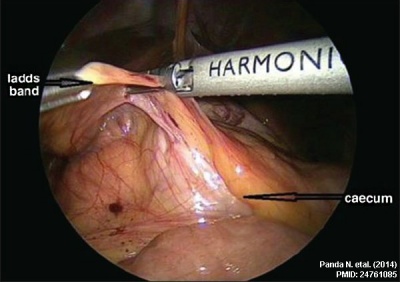
Ladd's band endoscopic view in adult.[4] |
| Australian GIT Abnormalities (2002-2003) |
|---|
Oesophageal atresia/stenosis - (2.0 per 10,000 births) ICD-10 Q39.0–Q39.3
|
Small intestinal atresia/stenosis - (2.4 per 10,000 births) ICD-10 Q41.0-Q41.2
|
Anorectal atresia/stenosis - ( 3.1 per 10,000 births) ICD-10 Q42.0–Q42.3
|
Hirschsprung’s disease - (1.3 per 10,000 births) ICD-10 Q43.1
|
Exomphalos - (Omphalocele) (2.1 per 10,000 births) ICD-10 Q79.2
|
Gastroschisis - (2.6 per 10,000 births) ICD-10 Q79.3
|
|
| Australian Palate Abnormalities (2002-2003) |
|---|
| Cleft lip with or without cleft palate (9.2 per 10,000 births) ICD-10 Q36.0, Q36.1, Q36.9, Q37.0–Q37.5, Q37.8, Q37.9 |
A congenital anomaly characterised by a partial or complete clefting of the upper lip, with or without clefting of the alveolar ridge or the hard palate. Excludes a midline cleft of the upper or lower lip and an oblique facial fissure (going towards the eye).
|
| Cleft palate without cleft lip (8.1 per 10,000 births) ICD-10 Q35.0–Q35.9 |
A congenital anomaly characterised by a closure defect of the hard and/or soft palate behind the foramen incisivum without a cleft lip. This anomaly includes sub-mucous cleft palate, but excludes cleft palate with a cleft lip, a functional short palate and high narrow palate.
|
|
| ICD10 Other congenital malformations of the digestive system (Q38-Q45) |
|---|
| XVII Congenital Malformations - Other congenital malformations of the digestive system (Q38-Q45) |
| Q38 Other congenital malformations of tongue, mouth and pharynx
Excl.: macrostomia (Q18.4) microstomia (Q18.5)
|
Q39 Congenital malformations of oesophagus
|
Q40 Other congenital malformations of upper alimentary tract
|
| Q41 Congenital absence, atresia and stenosis of small intestine
Incl.: congenital obstruction, occlusion and stricture of small intestine or intestine NOS Excl.: meconium ileus (E84.1)
|
| Q42 Congenital absence, atresia and stenosis of large intestine
Incl.: congenital obstruction, occlusion and stricture of large intestine
|
Q43 Other congenital malformations of intestine
|
Q44 Congenital malformations of gallbladder, bile ducts and liver
|
| Q45 Other congenital malformations of digestive system
Excl.: congenital: diaphragmatic hernia (Q79.0) hiatus hernia (Q40.1)
|
|
World Health Organisation. International Statistical Classification of Diseases and Related Health Problems. (1992) 10th Revision (ICD-10). Geneva: WHO ICD-10 - 2016 Online (English) |
| Links: Gastrointestinal Abnormalities |
| ICD10 - Gastrointestinal | Genital | Renal | Integumentary |
| Australian Statistics - GIT (1981 - 1992). | |
|---|---|
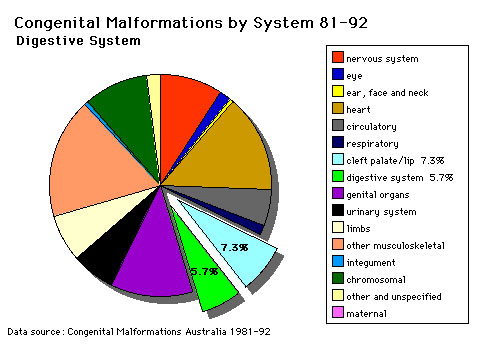
|
The pie diagram shows the relative contribution of major gastrointestinal tract abnormalities as a percentage of the total number of congenital abnormalities in Australia beween 1981 - 92.
Note that the digestive system represents approximately 6% of all major congenital abnormalities. One of the most common abnormalities occurring in (2% - 3% population) is Meckel's Diverticulum. The mouth (cleft lip, cleft palate) is part of the digestive tract, but more accurately reflects an abnormality of face formation. |
| Data shown as a percentage of all major abnormalities based upon published statistics using the same groupings as Congenital Malformations Australia 1981-1992 P. Lancaster and E. Pedisich ISSN 1321-8352. |
| USA Statistics - CDC National estimates for selected GIT related major birth defects (2004–2006). | |||||||||||||||||||||||||||
|---|---|---|---|---|---|---|---|---|---|---|---|---|---|---|---|---|---|---|---|---|---|---|---|---|---|---|---|
|
References
- ↑ Bower RJ, Sieber WK & Kiesewetter WB. (1978). Alimentary tract duplications in children. Ann. Surg. , 188, 669-74. PMID: 718292
- ↑ Akakpo-Numado GK, Gnassingbe K, Boume MA, Sakiye KA, Mihluedo-Agbolan K, Attipou K & Tekou H. (2012). Emergency treatment of a ruptured huge omphalocele by simple suture of its membrane. Ann Surg Innov Res , 6, 2. PMID: 22325297 DOI.
- ↑ Feldkamp ML, Carey JC & Sadler TW. (2007). Development of gastroschisis: review of hypotheses, a novel hypothesis, and implications for research. Am. J. Med. Genet. A , 143A, 639-52. PMID: 17230493 DOI.
- ↑ Panda N, Bansal NK, Narasimhan M & Ardhanari R. (2014). Laparoscopic correction of intestinal malrotation in adult. J Minim Access Surg , 10, 90-2. PMID: 24761085 DOI.
| Practical 1: Trilaminar Embryo | Early Embryo | Late Embryo | Fetal | Postnatal | Abnormalities | Lecture | Quiz |
BGDB: Lecture - Gastrointestinal System | Practical - Gastrointestinal System | Lecture - Face and Ear | Practical - Face and Ear | Lecture - Endocrine | Lecture - Sexual Differentiation | Practical - Sexual Differentiation | Tutorial
Glossary Links
- Glossary: A | B | C | D | E | F | G | H | I | J | K | L | M | N | O | P | Q | R | S | T | U | V | W | X | Y | Z | Numbers | Symbols | Term Link
Cite this page: Hill, M.A. (2024, April 27) Embryology BGDB Gastrointestinal - Abnormalities. Retrieved from https://embryology.med.unsw.edu.au/embryology/index.php/BGDB_Gastrointestinal_-_Abnormalities
- © Dr Mark Hill 2024, UNSW Embryology ISBN: 978 0 7334 2609 4 - UNSW CRICOS Provider Code No. 00098G

